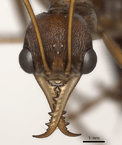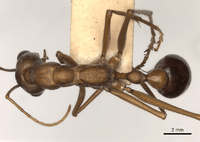Myrmecia nigriceps
| Myrmecia nigriceps | |
|---|---|
| | |
| Scientific classification | |
| Kingdom: | Animalia |
| Phylum: | Arthropoda |
| Class: | Insecta |
| Order: | Hymenoptera |
| Family: | Formicidae |
| Subfamily: | Myrmeciinae |
| Genus: | Myrmecia |
| Species: | M. nigriceps |
| Binomial name | |
| Myrmecia nigriceps Mayr, 1862 | |
| Synonyms | |
| |
Myrmecia nigriceps is a species of bull ant that is native to Australia. Various common names are in use including Bulldog Ant[1] It is very similar in appearance to Myrmecia gratiosa. It was first described in 1862.
It is distributed across southern states of Australia - including Western Australia, South Australia, Victoria and New South Wales.
Taxonomy
First identified by Gustav Mayr in 1862, the species was described under the binomial name Myrmecia nigriceps, based on syntype workers collected from Gayndah and Sydney.[2] Scottish born Australian entomologist John S. Clark published one synonym – Myrmecia fasciata, now considered a junior synonym.[3] M. nigriceps is a member of the genus Myrmecia, apart of the subfamily Myrmeciinae. Most ancestors of the genus are only found in fossils, with the exception of the ant Nothomyrmecia macrops.[4][5]
Description



Myrmecia ants, including this species have powerful and venomous stings and powerful mandibles.[6] The size of worker ants varies from 19 to 23 millimetres (0.75 to 0.91 in), with the queens being the largest at 24 to 26 millimetres (0.94 to 1.02 in) and males being around similar sizes to worker ants at 18 to 20 millimetres (0.71 to 0.79 in).[7] The gaster is black in colour, while the head can appear black or red.[7] The thorax, node and postpetiole are either yellow or red.[7] The antennae, legs are yellowish in colour, while the jaws are yellow.[7] Queens of a colony will look similar to the workers, but males are rather easy to identify.[7]
Behaviour
M. nigriceps ants are nocturnal foragers and will search for food during the night.[8] Research has shown differences in vision between ants in colonies,[9] as well as venom in the ant bite.[10] M. nigriceps ants are able to enter another colony of the same species without being attacked, as they may be unable to recognize alien conspecifics, nor do they try to distinguish nestmates from ants of another colony.[11][12]
Gallery
-

A member of Myrmecia nigriceps patrols for food in south east Australia.
-

A member of Myrmecia nigriceps adopts a defensive aggressive position.
-
at entry of nest in Darling Range, Western Australia
-
at entry of nest in Darling Range, Western Australia
References
- ↑ "Bulldog Ant (Myrmecia nigriceps)". Ozanimals.com. Retrieved 24 November 2014.
- ↑ Mayr, Gustav (1862). "Myrmecologische Studien". Verhandlungen der Zoologisch-Botanischen Gesellschaft in Wien 12: 649–776.
- ↑ Ogata, K.; Taylor, R.W. (December 1991). "Ants of the genus Myrmecia Fabricius: a preliminary review and key to the named species (Hymenoptera: Formicidae: Myrmeciinae)". Journal of Natural History 25 (6): (page 1659, Junior synonym of Myrmecia nigriceps). doi:10.1080/00222939100771021.
- ↑ Wilson, Edward O.; Hölldobler, Bert (17 May 2005). "The rise of the ants: A phylogenetic and ecological explanation". Proceedings of the National Academy of Sciences 102 (21): 7411–7414. doi:10.1073/pnas.0502264102. PMC 1140440. PMID 15899976.
- ↑ Archibald, S.B.; Cover, S. P.; Moreau, C. S. (2006). "Bulldog Ants of the Eocene Okanagan Highlands and History of the Subfamily (Hymenoptera: Formicidae: Myrmeciinae)" (PDF). Annals of the Entomological Society of America 99 (3): 487–523. doi:10.1603/0013-8746(2006)99[487:BAOTEO]2.0.CO;2.
- ↑ "Formicidae - Ants". Commonwealth Scientific and Industrial Research Organisation (CSIRO) Entomology. Retrieved 14 September 2014.
- ↑ 7.0 7.1 7.2 7.3 7.4 Clark, John (1951). The Formicidae of Australia (Volume 1) (PDF). Melbourne: Commonwealth Scientific and Industrial Research Organisation, Australia. pp. 66–67 (63 for synonym). Retrieved 24 November 2014.
- ↑ Brown, William (1953). Revisionary notes on the ant genus Myrmecia of Australia (PDF). Cambridge, Massachusetts: Museum of Comparative Zoology, Harvard University. p. 32.
- ↑ Thomas, Abbie (6 October 2010). "Bull ants have right eye for the job". ABC Science (Australian Broadcasting Corporation). Retrieved 24 November 2014.
- ↑ "Reports from Flinders University Highlight Recent Research in Arthropod Venoms", Health & Medicine Week (NewsRX), 2011-09-05: 1133, ISSN 1531-6459
- ↑ Gordon, Deborah M. (2010). "5". Ant encounters: interaction networks and colony behavior. Princeton, N.J.: Princeton University Press. p. 104-105. ISBN 978-0691138794. Retrieved 24 November 2014.
- ↑ van Wilgenburg, E; Dang, S; Forti, AL; Koumoundouros, TJ; Ly, A; Elgar, MA (September 2007). "An absence of aggression between non-nestmates in the bull ant Myrmecia nigriceps.". Die Naturwissenschaften 94 (9): 787–90. doi:10.1007/s00114-007-0255-x. PMID 17458525.
External links
| Wikimedia Commons has media related to Myrmecia nigriceps. |

